The Ancient City of Hierapolis, nestled in the picturesque region of Pamukkale, is an ancient city and UNESCO World Heritage site known for its well-preserved Greco-Roman ruins and sacred history.
Walking the cobbled streets of Hierapolis is like taking a captivating journey through time, uncovering the rich cultural heritage, healing hot springs, and remarkable architectural remains of this ancient sacred site.
If you’re planning a trip to Pamukkale and you’re wondering what Hierapolis is all about, in this guide we offer an in-depth exploration of Hierapolis, from its fascinating history to how to visit, as well as share what there is to see and answering some commonly asked questions.
Want to discover the allure of this ancient city? Get ready for a trip into the past.
History of The Ancient City of Hierapolis
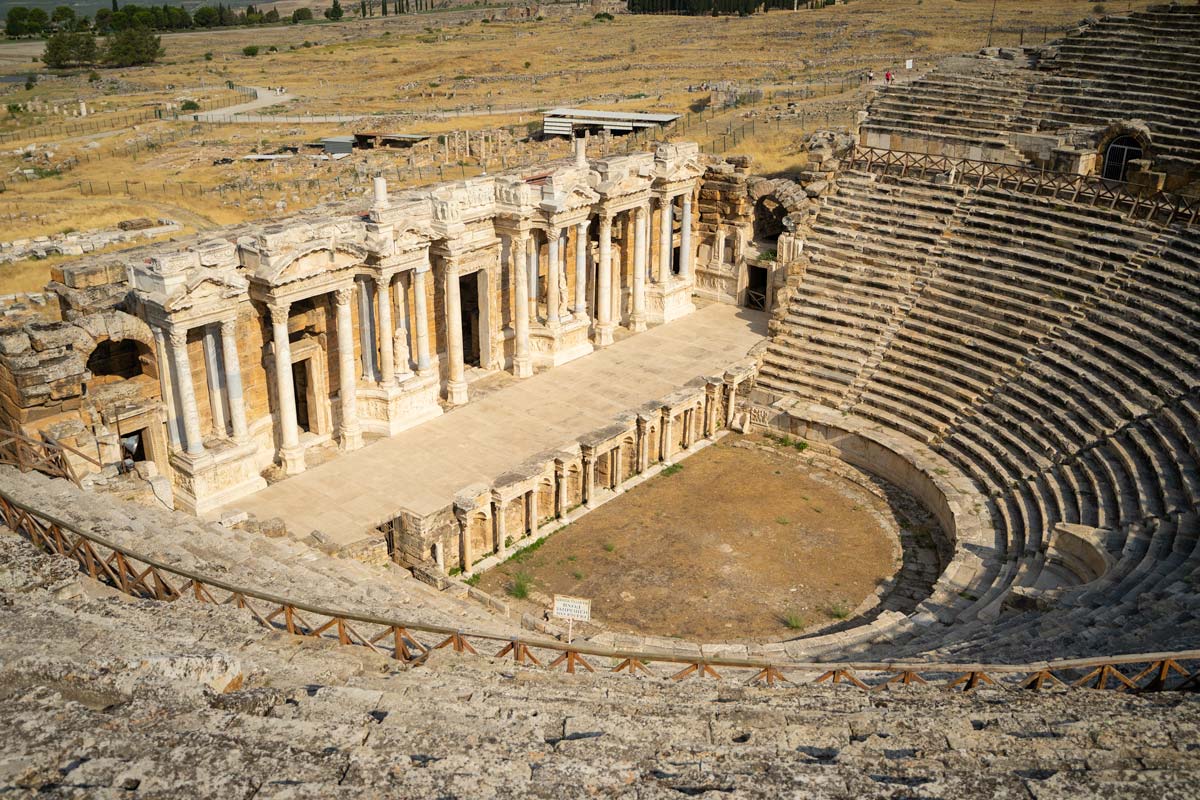
Hierapolis is an ancient city in Pamukkale, a small town in Southwestern Turkey. While little is known about how Hierapolis was founded, experts believed it was established during the Phrygian period in 190 BCE by King Eumenes II of Pergamon.
What is known it that the city was an important religious site, which we know from the word “hieron” meaning “a sacred place” in Greek. The city was thought to have been a “cult center”, which is evidenced by the temples and places of worship dotted around the site.
It’s believed preachers from far and wide would come to Hierapolis to spread the word of the mother goddess Cybele, who in Ancient Greek was considered the Mother of All Gods and Beings. She was mostly associated with fertility and motherhood, as well as nature and agriculture.
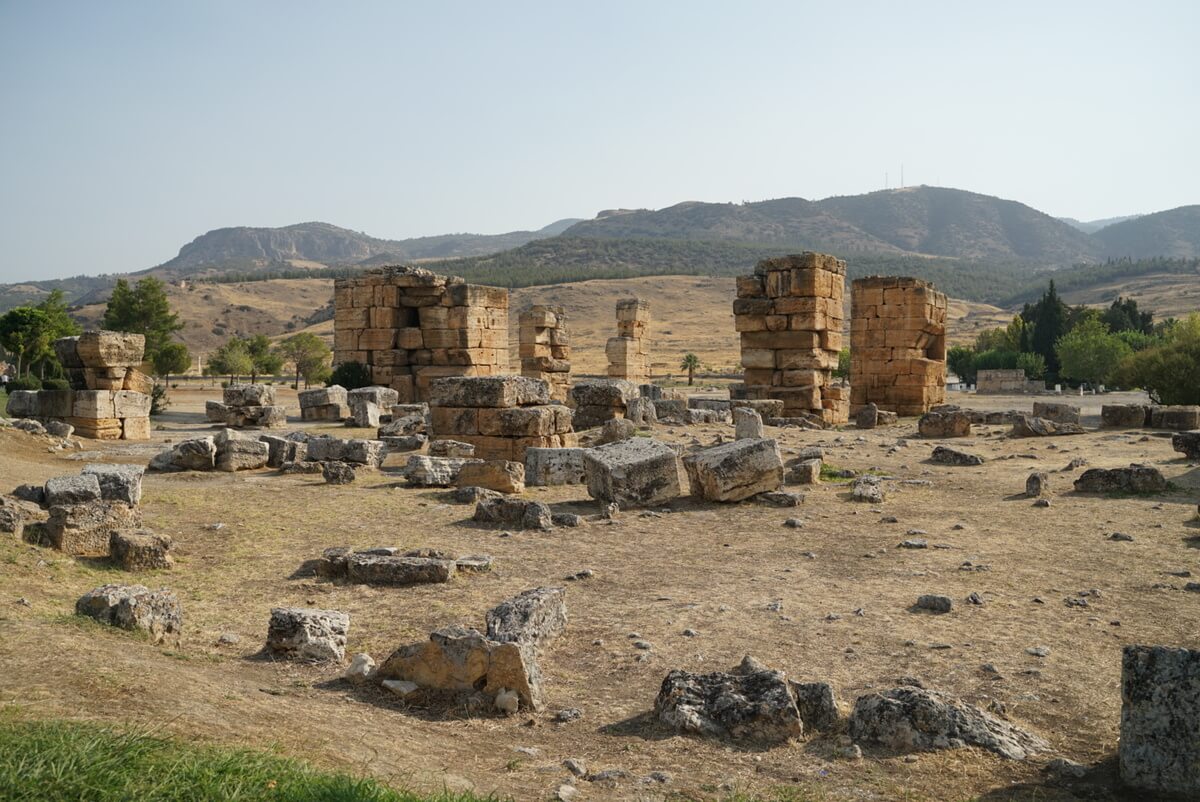
She was worshiped a lot by the people of Pergamon, and you can find many temples dedicated to her throughout Turkey. Some temples dedicated to her are still being uncovered, the most recent of which being in Bergama, just a short drive from Izmir.
Archeological excavations have also found evidence of worship of Apollo Lairbenos (God of the Sun), as well as Kareios, (God of Oracles), Artemis (Goddess of Nature, Wildlife, Healing and the Hunt), Pluto (Ruler of the Underworld) and Poseidon (God of the Sea).
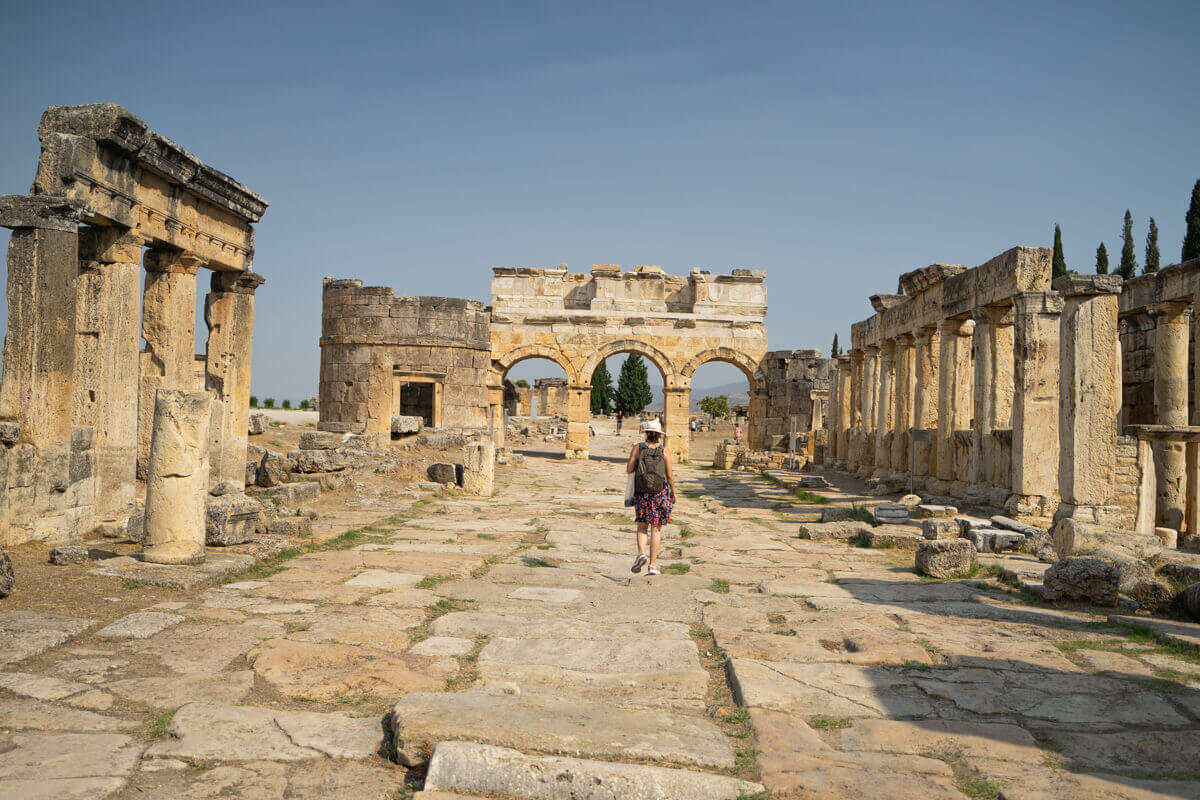
Hierapolis sits on the fault lines of the Anatolian microplate, which means it has seen several earthquakes throughout the years. In 60AD, Hierapolis was struck by a devastating earthquake, causing widespread destruction and damage. However, the city was wealthy, and was able to promptly rebuilt and become a thriving cultural and educational center once more.
It was also rebuilt during the Roman period in 14-37 CE, by Emporer Tiberius, which is why many ruins and monuments have a Greco-Roman style.
Hierapolis was not only a sacred place, but a place of healing. Thermal waters from a nearby spring have not only shaped the landscape, creating the famous Cotton Castle Travertine Terraces in Pamukkale, but have been believed to have healing properties from as early as the 5th Century BC.
In its prime, Hierapolis housed a renowned medical school and attracted visitors from across the Roman Empire seeking medical treatment.
With so many people flocking to the city for its healing properties, the city expanded rapidly, and a grand theater with a seating capacity of up to 15,000 people was built. This served as a hub for various performances and events.
Further evidence of the city’s wealth can be found in the necropolis, an extensive burial ground which features elaborately decorated tombs and sarcophagi.
In 1334, Hierapolis was abandoned following a devastating earthquake. Its ruins remain remarkably well-preserved, and it was added to the UNESCO Heritage Site list in 1988.
How to Visit The Ancient City of Hierapolis
Getting there
Hierapolis is located in the town of Pamukkale, just 16km north of Denizli. To get to Hierapolis from Denizli, you can take a minibus from the Denizli Bus Terminal (Denizli Otogari in Turkish).
There are frequent minibuses, known as dolmuş, that depart from the bus terminal every 15-20 minutes. These dolmuş services operate regularly throughout the day and will take you directly to Pamukkale, the town located near Hierapolis.
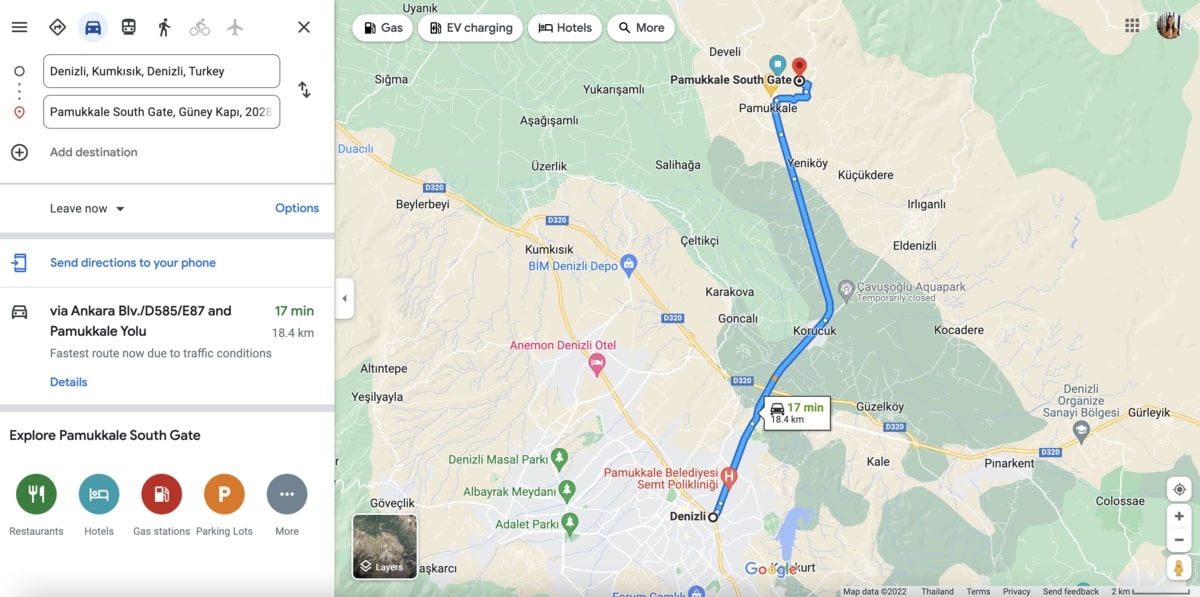
The minibuses depart from the lower level, B1. You will need to look for Gate 76 (it’s not really a gate, more of a bus stop) and you’ll find the minibus going to Pamukkale. The ride takes about 20-30 minutes and they depart when they are full.
The minibus drops you off in the town center of Pamukkale, and from here you can walk to the Lower Gate (also known as the Town Entrance), which takes you up the hill through the Travertine Terraces, and you’ll find Hierapolis at the top.
Alternatively, take a taxi to the North Entrance. You can walk to the North Entrance, but it takes an hour and our experience of Pamukkale is that it’s hot all year round, so we don’t advise walking.
Visiting Pamukkale from out of town? Here are some guides to help you get there.
How to visit for sunrise
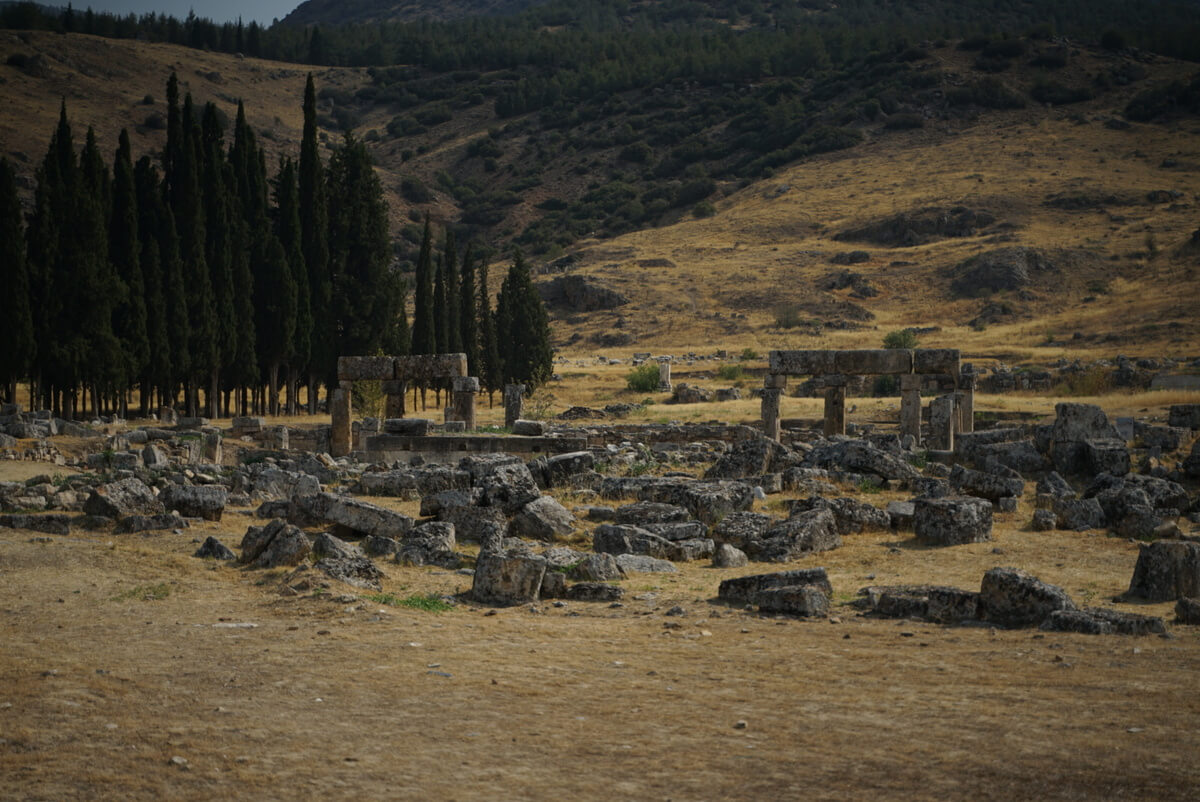
Hierapolis and the Travertine Terraces are the biggest attraction in the area (in fact, I would say it’s the only attraction) and so by 10.00am when the coach tours rock up, it becomes a frenzy of people.
If you want to experience Hierapolis in peace and quiet, head there for sunrise.
The North Entrance is the only entrance that opens at 6.30am, so if you want to beat the crowds, set your alarm early and head to this entrance. There may not be taxis around at this time, but thankfully it’s early morning so the temperature will be cool enough to do the walk.
Opening Hours & Entrance Fees
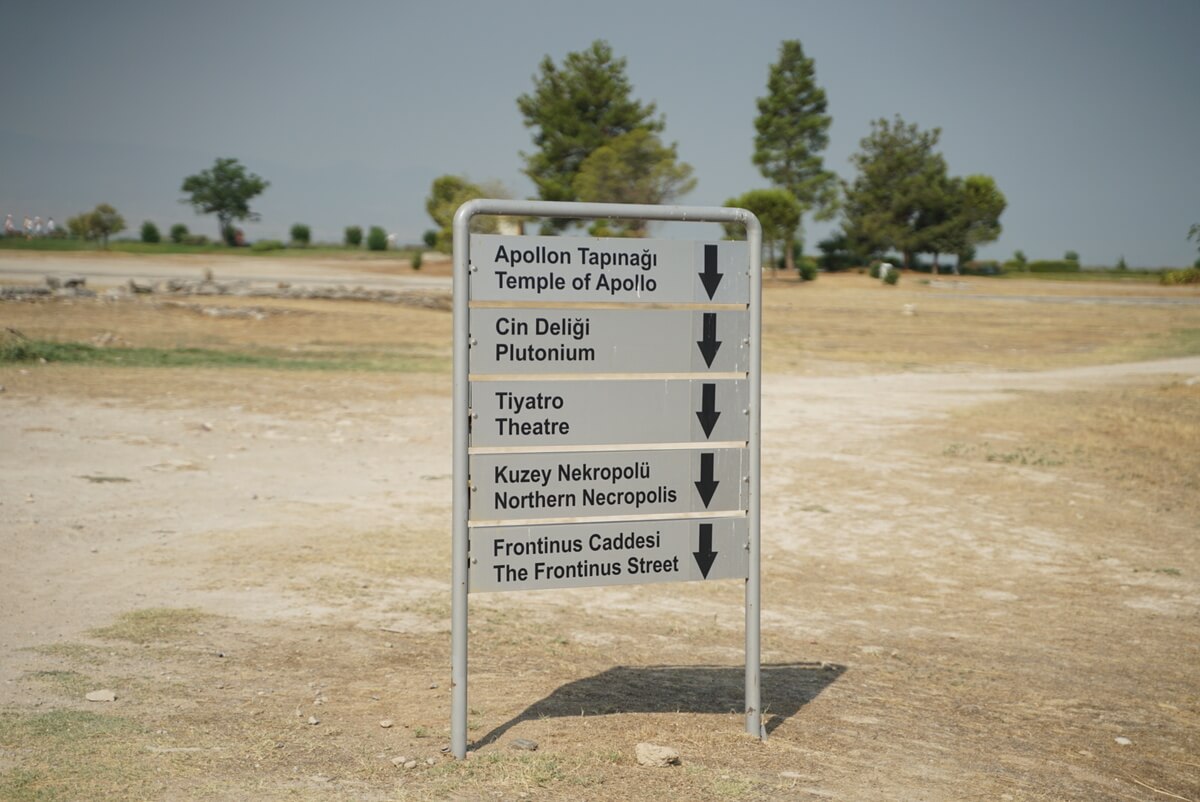
The opening hours for Hierapolis differ depending on which entrance you visit from. The North Entrance opens from 6.30am and closes at 8.00pm in the summer,
The South Entrance opens from 7:00am – 6:00pm, and the Pamukkale Town Entrance / Lower Gate opens at 8.00am until 9.00pm.
Entrance tickets allow you to visit the Travertine Terraces, the ruins of Hierapolis Ancient City and the Hierapolis Archaeological Museum.
The entrance fee is 30 Euros per adult. You can pay by card, or by cash using Turkish Lira.
The Hierapolis Archaeology Museum is open from 9.00am until 12:30pm, and from 1.30pm until 7.00pm, but is closed on Mondays.
The Cleopatra’s Antique Pool is open from 9.00am until 7.00pm, last entry at 6:15pm, and costs an additional fee of 200 Turkish Lira.
Read more ???? The Ultimate Istanbul, Cappadocia & Pamukkale Itinerary For 2024!
Getting Around Hierapolis
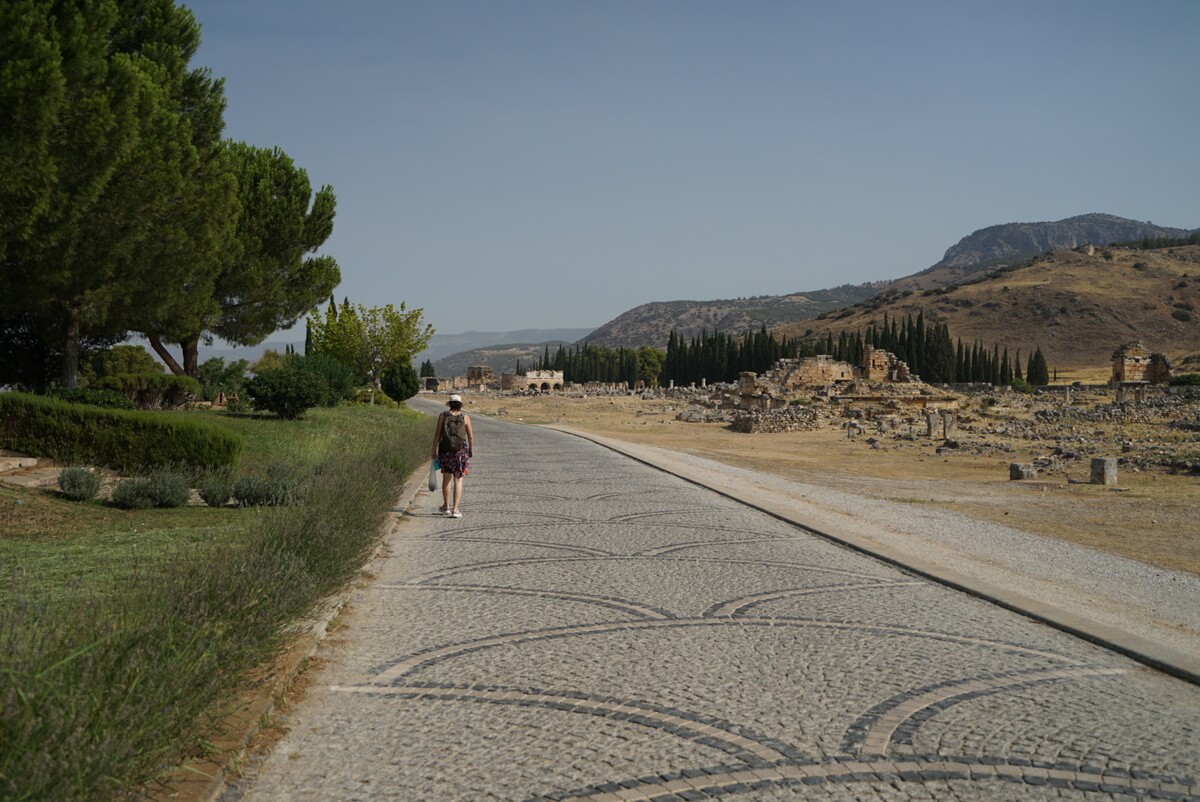
There are two ways to get around Hierapolis; by foot and by golf buggy. I wasn’t prepared for how big Hierapolis is, and wasn’t aware of the golf buggy until it was time for us to leave and we saw someone driving one.
In hindsight, a golf buggy would have been worth the additional expense, especially if you’re traveling with kids or have mobility issues.
Hierapolis is mostly exposed to the elements, and while mostly flat and cobbled, the entire complex is spread over an area of 2,700 meters (8,860 ft) by 600 meters (1,970 ft), and our legs and feet were quite tired afterwards (and we’re big hikers).
You can hire a golf buggy from either the North Gate or South Gate entrances. You can hire them individually or as part of a guided tour. There are not a lot of buggies for hire, so get there early to avoid disappointment.
If you don’t want to get a golf buggy, Hierapolis is very walkable, just be prepared for some aching limbs afterwards – hey, at least you can soothe them in the Travertine Terraces!
Highlights of The Ancient City of Hierapolis
Now you know the history of the city and how to get there, here are some of the most unmissable sites and landmarks in the archeological complex.
Hierapolis Archaeological Museum
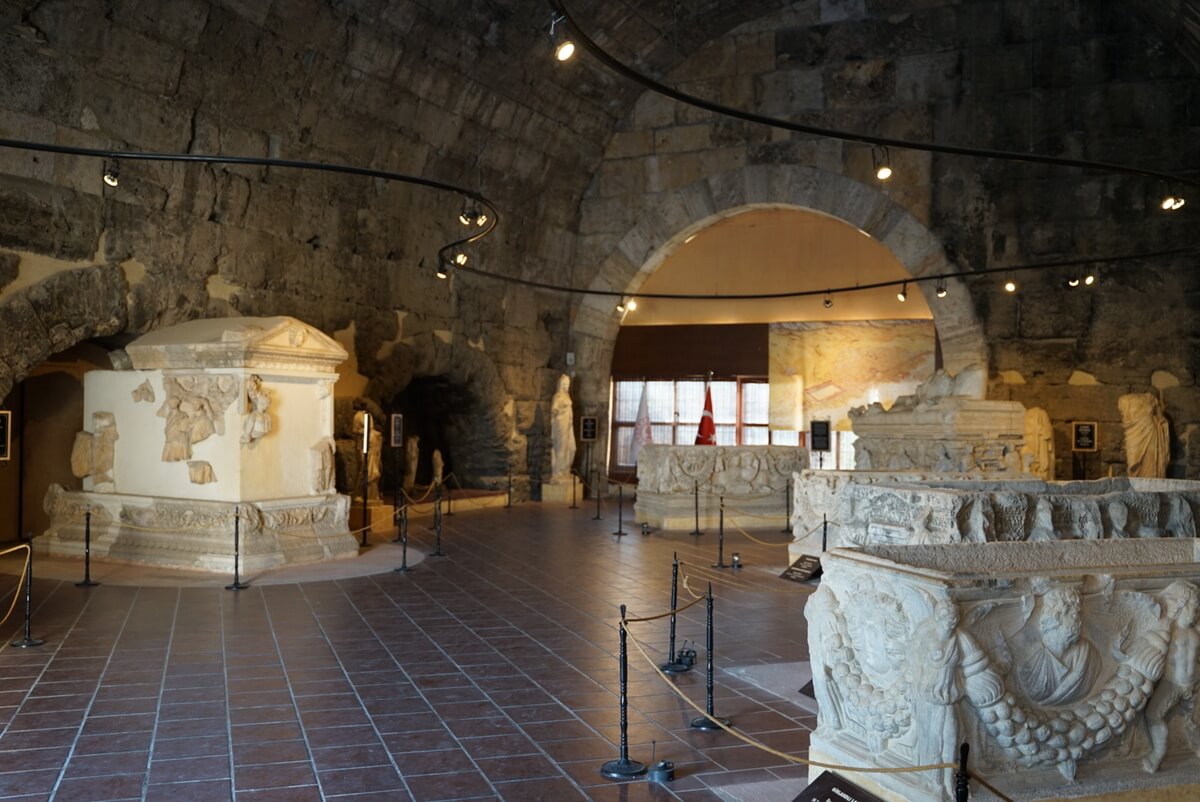
The Hierapolis Archaeological Museum is home to a small collection of artefacts that were discovered during excavation of the ancient city of Hierapolis.
The museum showcases a wide range of archaeological finds, including sculptures, inscriptions, and everyday objects that offer insight into the daily life and culture of the city.
Some of the most notable artefacts are the collection of sarcophagi, which are intricately carved and decorated with detailed reliefs.
The museum also houses a collection of Roman and Hellenistic sculptures, as well as a variety of artefacts from the city’s ancient baths, temples, and theaters.
In addition to the artefacts on display, it’s also a good place to learn more about the historical context and background of Hierapolis and its significance in the region.
The Cleopatra Antique Pools

These thermal pools are not only a great place for a swim, but are also believed to have been visited by the famous Egyptian queen Cleopatra (hence the name, Cleopatra Pools).
The pools are fed by natural hot springs, and the water is rich in minerals, which is said to have therapeutic and rejuvenating properties.
The Cleopatra Antique Pools are an additional fee to swim in, and can often be crowded, so it’s a good idea to get here early to beat the swarms of visitors.
The crystal-clear, mineral-rich waters are a relaxing and rejuvenating experience, and you get to say you have swum in the same waters that Cleopatra herself…
Hierapolis Ancient Theater
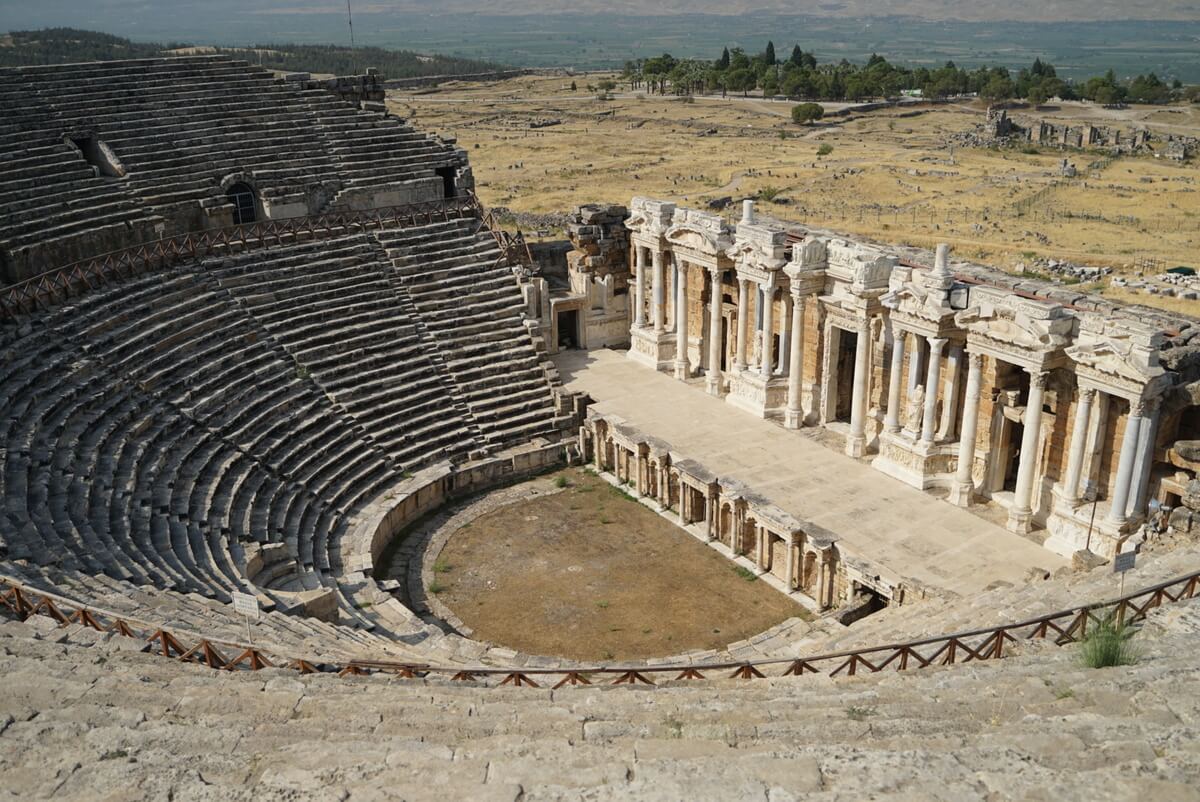
Perhaps the most famous ruin in Heirapolis is the Hierapolis Ancient Theater, an impressive and well-preserved structure that dates back to the Hellenistic period (but was later renovated and expanded during the Roman era). The result is a combination of Greek and Roman architectural styles.
The theater has a capacity of approximately 10,000-20,000 spectators in forty-five rows of seats and is renowned for its excellent acoustics and stunning panoramic views of the surrounding landscape.
It was used as a venue for various performances, such as plays, live music, and religious ceremonies, making it a central hub of cultural and social life in ancient Hierapolis.
The Martyrium of St. Philip
One of the most significant religious sites in Hieropalis is The Martyrium of St. Philip, a temple dedicated to St. Philip the Apostle, one of the twelve disciples of Jesus Christ.
The site is believed to be the location where St. Philip was martyred and buried. Here you can see the ruins of a church and a monumental octagonal tomb structure, which is believed to be the final resting place of St. Philip.
It is thought the temple was constructed in the early 5th century AD, making it a revered pilgrimage destination for Christians.
This section of the complex also includes a baptistery, a colonnaded courtyard, and other architectural features that reflect the religious and cultural importance of the site.
Temple of Apollo
The Temple of Apollo is an ancient religious site dedicated to the Greek God, Apollo. It’s thought this temple would have been built in the 3rd century BC. It was later expanded and renovated during the Roman era, reflecting a blend of architectural styles and influences.
The Temple of Apollo was a significant center of worship and cultural activity in ancient Hierapolis. It served as a place for religious ceremonies, festivals, and oracular practices associated with the god Apollo.
The temple complex includes a grand colonnaded courtyard, a monumental altar, and a sanctuary dedicated to Apollo.
The Agora
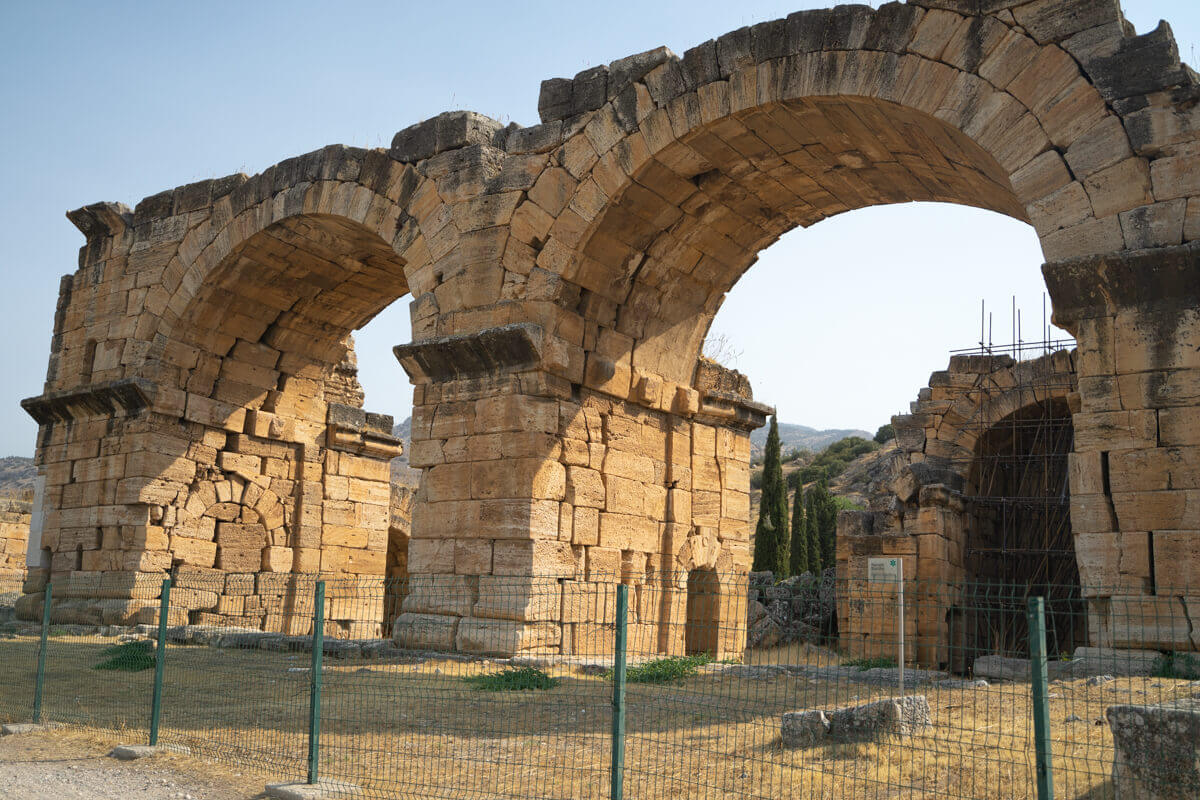
The Agora was an ancient marketplace and civic center that played a central role in the economic, social, and political life of the city.
The Agora was a bustling hub of commercial activity, where merchants, traders, and artisans gathered to sell their goods and exchange goods and services.
The site features a large open square surrounded by colonnades, with ruins of shops, administrative buildings, and public spaces lining the perimeter.
The Agora also served as a venue for public gatherings, political discussions, and cultural events, making it a vital focal point for the community.
The Agora also holds religious significance, and features the ruins of temples and altars dedicated to various deities around the complex. These religious structures were what revealed Hierapolis to be a center of spirituality in ancient times.
The Plutonium
The Plutonium is an ancient site shrouded in mystery. The Plutonium is a cave, or grotto, that was associated with the god Pluto, the Greek god of the underworld.
It was believed to be an entrance to the underworld during ancient times, and the site was revered for its supposed mystical and otherworldly properties.
The cave was known for emitting toxic gases, particularly carbon dioxide, which were believed to be manifestations of the underworld’s powers.
It was this poisonous gas gave rise to the belief that the cave was a gateway to the realm of the dead.
Priests and priestesses would use the phenomena within the cave as a way to preach omens and messages from the gods.
Today, the Plutonium remains a site of archaeological interest.
The Frontinus Street and Gate
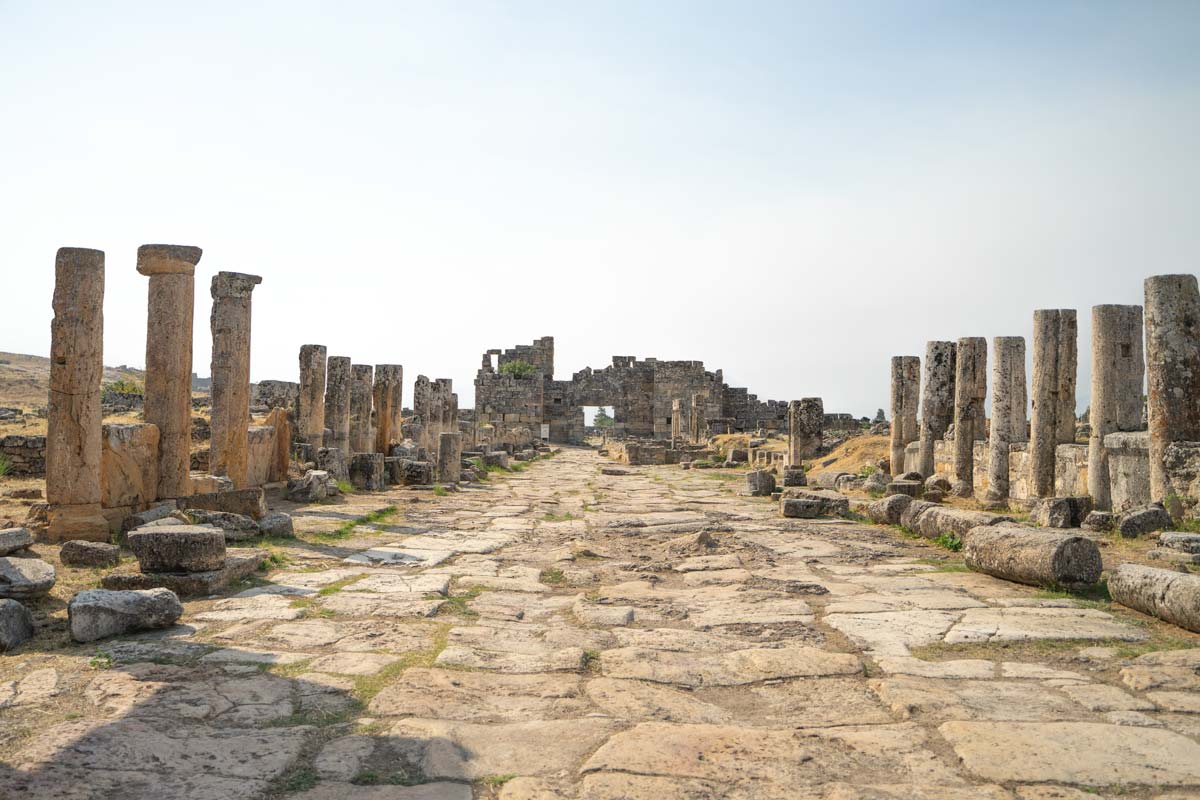
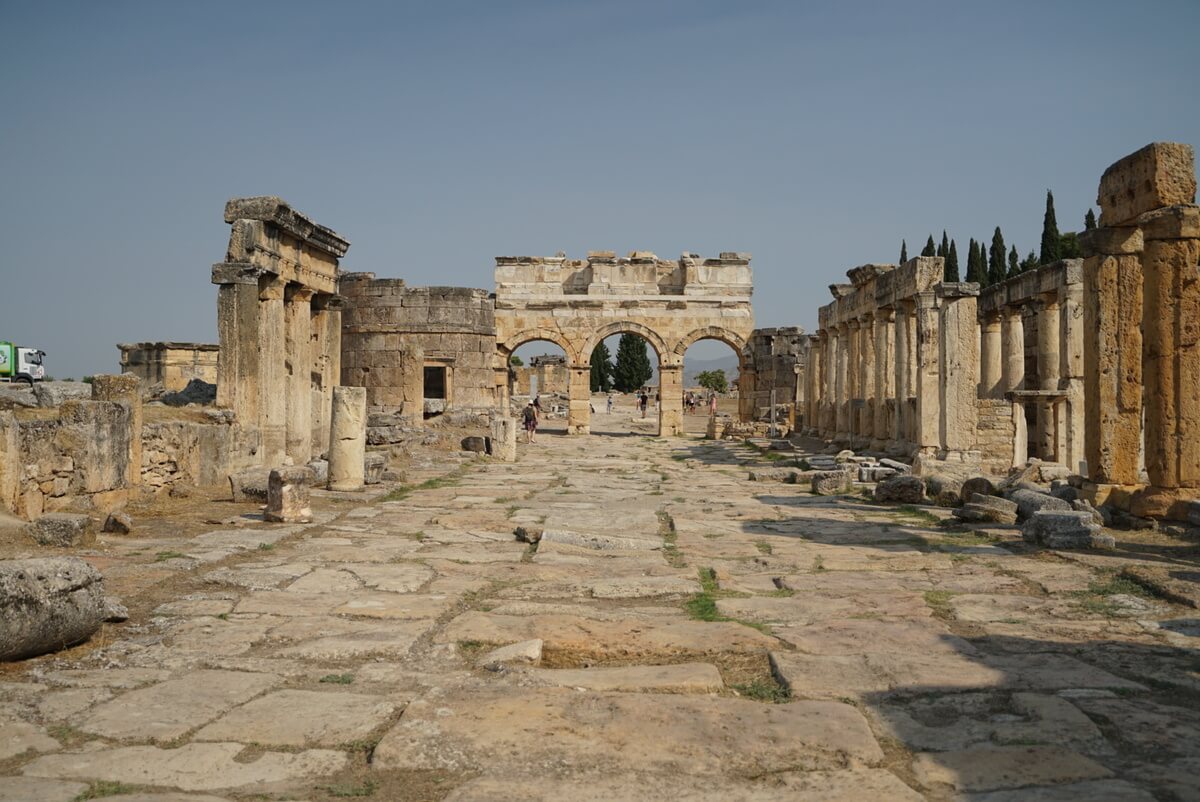
Frontinus Street was a major thoroughfare, serving as a central artery for commerce, transportation, and social interaction in ancient Hierapolis.
The street was lined with shops, public buildings, and residential structures, reflecting the bustling activity and vibrant urban life of the city.
At the northern end of the street is Frontinus Gate, which would have been the city’s defensive walls. The gate was a key element of the city’s fortifications, providing access to the city while also serving as a defensive stronghold against potential threats.
The Necropolis
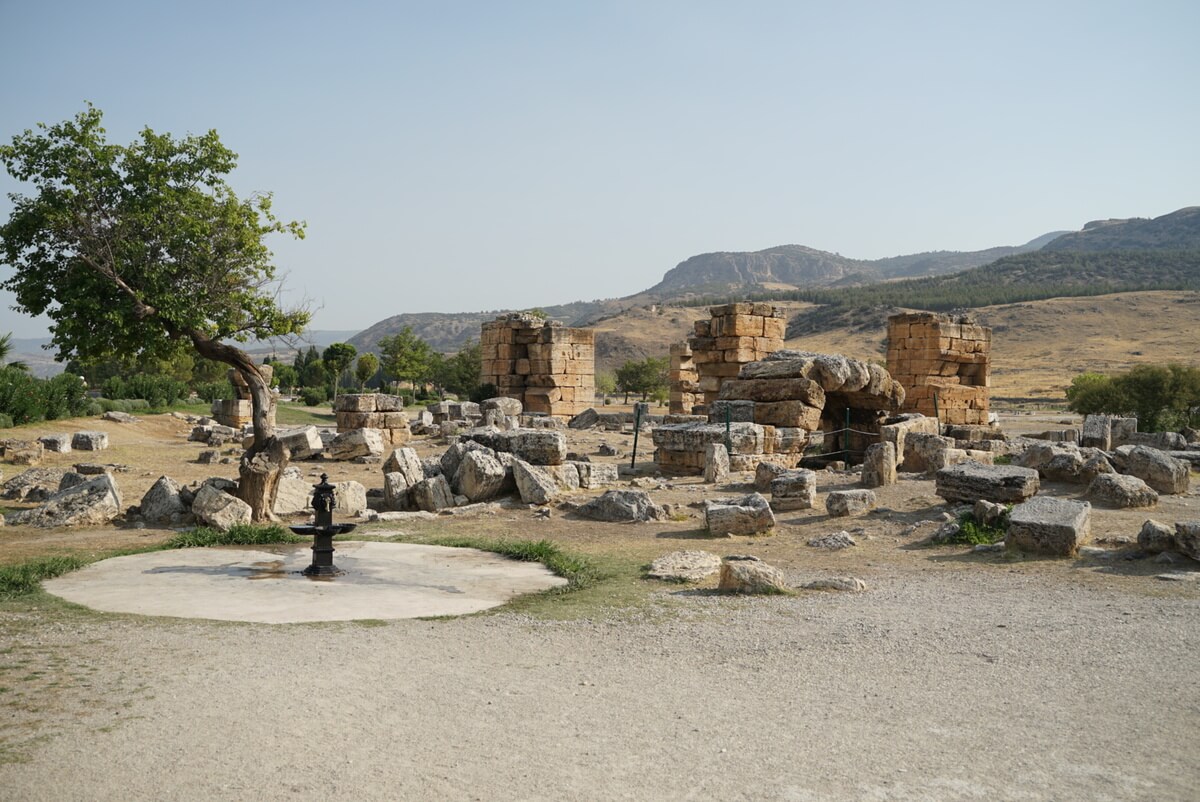
The Necropolis is an ancient burial ground. The word necropolis translates to “city of the dead” in Greek, and it’s here that you will find the final resting place for the inhabitants of ancient Hierapolis.
The necropolis comprises of a vast expanse of tombs, sarcophagi, and funerary monuments. Some ruins are better preserved than others.
Some tombs are not always obvious, and are often buried under mountains of stone, or marked by fallen grave stones.
When walking around, look carefully at the rocks lying on the floor, and see how many tomb stones you can spot.
The Necropolis was strategically located outside the city walls, reflecting the ancient belief in maintaining a separation between the realms of the living and the dead.
The North Gate
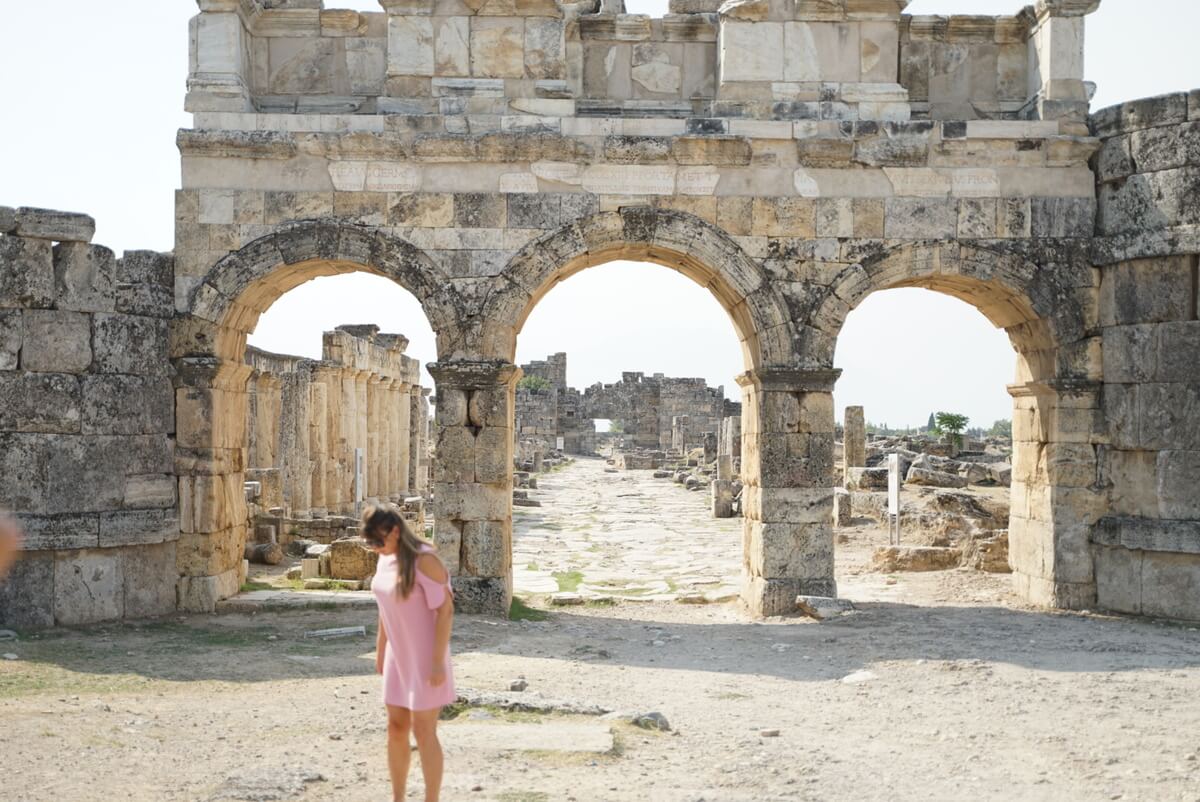
The North Gate served as a pivotal entry and exit point for the city. The North Gate was a key component of the city’s defensive fortifications, and dates back to the Hellenistic and Roman periods.
The gate was an integral part of the city’s urban layout and played a crucial role in controlling the flow of traffic in and out of Hierapolis.
The North Gate was designed with both practical and defensive considerations in mind, featuring architectural elements such as towers, ramparts, and fortified passages.
Map of The Ancient City of Hierapolis
To help you get around Hierapolis and to find each landmark mentioned above, here is a helpful map of the complex with each site marked.
FAQs About Visiting The Ancient City of Hierapolis
Do you need the audioguide when visiting Hierapolis?
Yes, I recommend you get an audioguide when visiting Hierapolis, as there are signs but they are not very detailed. The audioguide has more information.
How long does it take to see Hierapolis?
It takes on average 3-4 hours to see Hierapolis, including visiting the Travertine Terraces and Hierapolis Archeology Museum. This could be seen faster if you rent a golf cart to get around instead of walking.
Is the Ancient City of Hierapolis worth seeing?
Yes, Hierapolis is worth seeing. Not only is the history fascinating, but the ruins are well preserved and intricately detailed. The entrance ticket to Hierapolis also includes the Travertine Terraces and Hierapolis Archeology Museum, which also adds to the appeal of visiting.
Tips for Visiting Hierapolis
- Wear sturdy footwear. The terrain is ancient cobbled streets mixed with loose stone and sand, so closed shoes with plenty of tread are advised. Note that you have to remove your shoes when walking on the Travertine Terraces.
- Bring plenty of water. It can get hot when visiting Hierapolis and there is little shade throughout the whole complex. Try to stay hydrated as best as you can.
- Leave the drones at home. You cannot fly drones in Hierapolis and there are security guards roaming the whole complex and asking people to leave if they fly them, so don’t let that be you.
- Take your trash with you. There are no trash containers, as far as we could see, so remember to take your trash home with you.
- Wear sun protection. The sun can be intense, especially in the summer months, so don’t forget to bring sunscreen.
- Wear respectful attire. Although this is a historical site, it’s still a sacred site, and it’s important to dress modestly and respectfully.
- Get the audioguide. There is a serious lack of signage when walking around Hierapolis, so get the audioguide so you can learn about what you are looking at. Alternatively, consider hiring a local guide or joining a guided tour to gain a deeper understanding of the history and significance of the city.
- Visit the Hierapolis Museum. Although small, the Hierapolis Archaeology Museum should not be skipped. It houses a remarkable collection of artifacts and displays that provide context to the ruins of this ancient city.
- Prepare for crowds. Hierapolis is a popular tourist destination, so be prepared for crowds, especially during peak tourist seasons.
Final Thoughts
Hierapolis was a surprisingly fascinating destination and a highlight of our trip to Turkey. We’ve visited a few archeological sites in Turkey now, including the famous Ephesus and Ancient City of Perge, but Hierapolis is unlike any of the others.
It’s vast, it’s ruins still feature intricate details, and the theater is one of the most well preserved ancient theaters we have seen in Turkey (with the possible exception of Aspendos).
I hope this guide helped you plan your trip to Hierapolis and gave you some insight into its history, what there is to see, and how to get there and around.
If you have any questions about visiting Hierapolis, reach out to us in the comments.

Hi Louisa,
Great article and we just visited yesterday. I have a question about how the Romans built the mini aqueducts. Do you know?
– Brian
Hi Brian,
Thank you for your comment! I am not personally familiar with how aqueducts are made, but I read a great article that explains how the Roman’s made the aqueducts at Hierapolis. You can read it here!